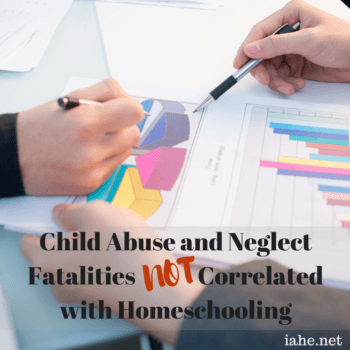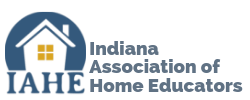By Dr. Brian Ray
The Context
Sadly, news stories, anecdotes, and some research regarding school teachers and other school personnel doing evil things to students and children have become common in the United States.[1], [2] News stories, government data, and research reports on parents harming children are also available.[3]
 During the past few years, some news stories have implied a special connection between child abuse, child neglect, or child fatalities and homeschooling. This brief paper addresses the following question: Has any research been done that provides any empirical evidence regarding the rates of child abuse, child neglect, or abuse-related child fatalities in homeschooling families compared to the rates in families who engage in public schooling or private schooling?
During the past few years, some news stories have implied a special connection between child abuse, child neglect, or child fatalities and homeschooling. This brief paper addresses the following question: Has any research been done that provides any empirical evidence regarding the rates of child abuse, child neglect, or abuse-related child fatalities in homeschooling families compared to the rates in families who engage in public schooling or private schooling?Methods
I have been carefully following research on homeschooling (home education, home-based education, homeschooling) since about 1983 and have acquired an extensive bibliography on it. A recent thorough search of available literature has resulted in identifying only three published reports relevant to the question posed in this paper – two original research studies and one report using publicly available data. Here I will focus on one of the original studies (i.e., Williams, 2017). [4]
Williams’ purpose is to calculate and compare child fatality rates in the general population and in the homeschool population and then address whether increasing government regulations on homeschoolers might be connected to reducing child fatality rates. The researcher used information from one organization that promotes more government regulation of homeschooling, the U.S. Department of Health and Human Services, and the U.S. Department of Education to calculate his key statistics.
In his analysis, Williams does a very important thing; he carefully defines terms. Here is how he explains this:
Gathering data on legal homeschoolers is complicated by the fact that truant parents masquerade as homeschoolers to avoid prosecution. This leads to public data classified as “homeschool” actually being an agglomeration of two separate groups: legal homeschoolers and truants masquerading as homeschoolers. So we need to carefully disaggregate the data into these two distinct types of students as we perform the following analysis. We label the jumbled up grouping as “those who claim to homeschool.
Williams then calculated the numbers. One is the “expected fatalities among legally homeschooled students” and the other is the “actual” number. The expected number is the hypothetical number one would find if the rates within homeschooling were the same as the rates in the general population.
Findings
The analysis reveals that the expected number of fatalities among legally homeschooled students was 55, while the actual number was lower, at 32. Williams concluded the following:
“Legally homeschooled students are 40% less likely to die by child abuse or neglect than the average student nationally. Truants, by contrast, are seven times as likely to die as the average student nationally.
That is, in families where people are legally homeschooling, there is a significantly lower incidence of child fatalities due to child abuse or child neglect.
The author hypothesizes about how different the data would have to be to move the fatality rate for legally homeschooled students to be as high as that of the national average. Here is one way that he explains it:
One way would be for the homeschool fatality count to move from 32 to 55. Correspondingly, the truant fatality count would need to move from 29 to 6. The truant classifications were based on specific reported characteristics or circumstances that indicated the parents would not have filed the homeschool paperwork. 23 out of 29 apparent truants being misclassified would be like 23 out of 29 people with an appearance of being intoxicated actually being sober. It is possible, but highly unlikely.
On this note, Williams writes that he “… knows of no evidenced-based theory of truancy which would yield that large an estimate of truants claiming to be homeschoolers, given the numbers and characteristics of homeschoolers.”
Conclusions
Based on the data, Williams concludes that students who are legally home educated (i.e., homeschooled) “… are 40% less likely to die by child abuse or neglect than the average student nationally.” He then finishes his piece on the topic of state regulation of private home-based homeschooling education.
The author correctly points out that there is nothing in the data or statistics to explain why there is a lower fatality rate among legally homeschooled students. That is, no one should say that current regulations caused the homeschool fatality rate to be lower or the general population fatality rate to be higher.
Williams makes the important following point: “There is no evidence for such a [causal] link. Public schools are highly regulated. Yet public school child fatality rates are higher than the rate for those legally homeschooling.”
In response to those who consistently push for more government controls over private home-based homeschooling education, Williams asks the following: “Why impose regulations on families who already are prone to a lower fatality rate than the rest of the nation? There appears to be no good reason.” 

There has been only one other study (of which this author is aware) that examined original data that are directly related to the rates of child abuse, child neglect, or child fatalities amongst public school, private school, and homeschool children.[5] That study asked one question regarding sexual abuse and found that adults who had been home educated reported being abused at a lower rate than those in two other schooling groups and at the same rate as a third group. Based on this limited base of research information, one could say that if there is a difference in rates of abuse or harm to children amongst schooling types, such abuse and harm is lower for the homeschooled. There is no reliable, empirical evidence that home-educated children experience any more abuse, neglect or fatalities due to neglect than do children who attend public or private institutional schools.
Rather than focus on how children are educated or schooled to find ways to reduce child neglect, abuse, and related fatalities, it appears that policymakers should give close attention to the report of the United States Commission to Eliminate Child Abuse and Neglect Fatalities (2016).[6] None of their specific steps to be taken mentioned the type of schooling in which children are found nor did their recommendations include regulating or controlling any type of educational or schooling environment. It is possible that if researchers and policymakers were to begin an in-depth examination of where child maltreatment or educator misconduct occurs more according to school type, they might find that a higher rate of harm is associated with institutional schooling;[7] perhaps future research will reveal more on this.
–Brian D. Ray, Ph.D.
P.S. Your donations help NHERI and Dr. Ray (1) keep up with new research to give you the truth about what is happening in the United States and around the world regarding homeschooling freedoms, research, and insights and (2) be ready to speak to scholars, journalists, courts, policymakers, and parents.
Two ways to help NHERI:
1. Send a check to: NHERI, PO Box 13939, Salem OR 97309 (using a check puts the largest percent of your gift to work at NHERI)
2. Donate online.
NHERI is a 501(c)(3) nonprofit organization.
Contributions are tax-deductible per law.
NHERI, PO Box 13939, Salem OR 97309, USA
Endnotes:
[1] Shakeshaft, Charol. (2004). Educator sexual misconduct: A synthesis of existing literature. Washington, DC: United States Department of Education. Retrieved February 7, 2017 from http://www2.ed.gov/rschstat/
[2] Stop Educator Sexual Abuse Misconduct and Exploitation. (2016). Retrieved January 25, 2016 from www.sesamenet.org
[3] Centers for Disease Control and Prevention. (2016). Child maltreatment prevention. Retrieved January 25, 2016 from www.cdc.gov/
[4] Williams, Rodger. (2017, January 3). Homeschool child fatalities fewer than the national average. Retrieved February 3, 2017 from http://thehomeschooleffect.
[5] Ray, Brian D. (2016, February 2). Homeschooling and child abuse, child neglect, and child fatalities. Retrieved February 7, 2017 from http://www.nheri.org/research/
[6] United States Commission to Eliminate Child Abuse and Neglect Fatalities. (2016).Within our reach: A national strategy to eliminate child abuse and neglect fatalities. Washington, DC: Government Printing Office. Retrieved February 1, 2017 fromhttps://www.acf.hhs.gov/sites/
[7] See: (a) Shakeshaft, Charol. (2004). Educator sexual misconduct: A synthesis of existing literature. Washington, DC: United States Department of Education. RetrievedFebruary 7, 2017, January 18, 2015, and December 18, 2012 fromhttp://www2.ed.gov/rschstat/
